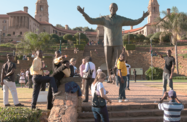Having benefitted from the surge in arrivals and a massive profile boost from last year’s World Cup, South Africa’s tourism industry is now facing a slightly more challenging environment. However, a shift in policy and more targeted promotions aimed at domestic travellers may soon get the industry moving again.
Tourism is a major part of South Africa’s economy, with the sector set to contribute 11.4% to GDP this year, representing $47bn, according to the World Travel and Tourism Council (WTTC). The sector will also directly and indirectly provide employment to more than 1.3m people, or 10% of the country’s workforce. Tourism’s role in the economy will only increase in the coming decade, with the WTTC predicting its contribution to GDP will rise to 11.5%, or $74.6bn by 2021. The number of workers employed in the sector is likewise expected to grow to 1.7m, or 10.7% of the total population.
However, while long-term industry prospects are solid, in the short term some in the sector are feeling the pinch. In the wake of the staging of the 2010 World Cup, many tourism operators had expectations of a continuing increase in arrivals, building on the surge of football fans that came during the event.
Shingi Munyeza, the CEO of regional hotel operator African Sun group, which closed one of its hotels in July and another in August, said an oversupply of rooms, combined with a fall in visitors and a shrinkage in corporate business immediately following the World Cup, has hurt the industry.
“The reduction in overseas visitors and domestic travellers, coupled with the continued pressure of the global recession and rapidly escalating running costs in South Africa, have made the businesses unsustainable,” he said in a statement issued in late August.
Other tourism experts say that while overall visitor numbers are actually rising, a deepening of the accommodation and hospitality pool prior to the World Cup means the industry is struggling to boost profits.
According to Calvyn Gilfillan, the CEO of Cape Town Routes, which promotes tourism opportunities in Cape Town and the Western Cape, the supply increase outweighs any arrival number improvements. “The demand has stayed the same, but we had an increase of 20% in accommodation and restaurants,” he told local media.
Data released by the tourism ministry in late August showed there was a 7.5% increase in overseas arrivals in the first four months of the year, with 2.75m foreign visits. However, there are concerns that, with the weakening economies of some traditional South African tourism markets, particularly Europe and the US, total visitor numbers could be flat this year.
Responding to this slowing of arrivals from long-established markets, South Africa has stepped up promotional activities in places like China, India and Latin America to develop alternative tourism sources.
However, it is at home where South Africa hopes to find the biggest new tourism source to sustain and develop the hospitality industry. On August 25, the minister of tourism, Marthinus van Schalkwyk, said it was essential to lift the profile of the sector’s domestic profile to overcome overseas market cooling.
“In difficult times we need to be even more united as the tourism industry to focus on markets that not only provide quick relief in the short term, but whose growth will be sustainable for many years ahead,” he said at an event promoting South Africa’s “Tourism Month”, which ran throughout September. “With domestic tourism contributing over 70% of our country's tourism volume and contributing to sustaining and creating much-needed jobs, the domestic market has to be one of our key focus areas.”
While committed to exploring tourism growth potential from emerging markets in Asia, the Americas and Africa, van Schalkwyk said domestic tourism remained the industry’s backbone and needed to be strengthened by better marketing and services.
“This investment in a value-conscious domestic tourism market should not be about short-term cash flows, but about creating an upstream reservoir for future growth. It should be about building the next generation of tourists that will help ensure long-term financial sustainability for our sector,” he said.
To be successful, South Africa’s own economy has to be healthy enough to encourage locals to take a break and holiday at home. Last year, 29.7m domestic trips were taken, down on the 30.3m the tourism ministry reported in 2009. With unemployment running at around 25% and economic growth at its lowest levels in almost two years, it may be some time before the domestic tourism segment’s full potential is achieved.

